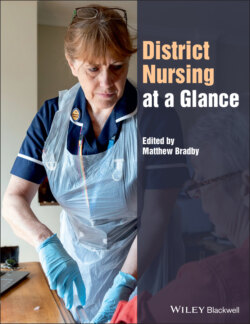Читать книгу District Nursing at a Glance - Matthew Bradby - Страница 14
2 History of the Queen’s Nursing Institute
ОглавлениеMatthew Bradby
Figure 2.1 Insignia of Queen Victoria’s Jubilee Institute for Nurses, 1887.
Source: Queen’s Nursing Institute.
Figure 2.2 Queen’s Nurse’s Outdoor Uniform, 1905.
Source: Queen’s Nursing Institute.
Figure 2.3 Uniform hat for Queen’s Nurses, 1913.
Source: Queen’s Nursing Institute.
Figure 2.4 Queen’s Nursing Institute badge for Jamaican nurses.
Source: Queen’s Nursing Institute.
Figure 2.5 Queen’s Nurse’s indoor uniform, 1943.
Source: Queen’s Nursing Institute.
Figure 2.6 Queen’s Institute of District Nursing logo, 1928.
Source: Queen’s Nursing Institute.
Figure 2.7 Queen’s Nursing Institute logo, 1973.
Source: Queen’s Nursing Institute.
Figure 2.8 Modern Queen’s Nurse badge. Source: Queen’s Nursing Institute.
The Queen’s Nursing Institute is a registered charity, created to organise the training of district nurses in the UK. It traces its origins to 1887 with a grant of £70,000 by Queen Victoria and a Royal Charter in 1889 named it Queen Victoria’s Jubilee Institute for Nurses. Its original objectives were the ‘training, support, maintenance of women to act as nurses for the sick poor and the establishment … of a home or homes for nurses and generally the promotion and provision of improved means of nursing the sick poor.’ William Rathbone, who had pioneered the concept of district nursing in 1859, and Florence Nightingale were closely involved in the creation of the new charity. Queen Victoria was the charity’s first Patron in a tradition that has continued to the present day: Her Majesty Queen Elizabeth II became Patron in 2002.
District nurses who undertook the Institute’s training and passed its examination were called Queen’s Nurses and were entitled to wear the badge and insignia of the Institute (Figures 2.1–2.3). Early training contained a broad range of subjects, including sanitary reform, health education, ventilation, water supply, diet, infectious diseases, sexual health, and the feeding and care of newborn infants (in this period, infant mortality was around 154 per 1000 live births). Queen’s Nurses began visiting schools in London when it was realised that school children suffered from a wide variety of ailments made worse by lack of treatment – a key milestone in the development of modern school nursing.
The Institute’s Council – its governing body – laid down the ‘Conditions of Affiliation’ for district nursing associations, the local charities that employed nurses until 1948. These conditions included the qualifications required of Queen’s Nurses, including training at an approved hospital or infirmary for at least a year; approved training in district nursing for at least six months; training in nursing of mothers and infants after childbirth (subsequently, this contributed to the development of the health visitor profession). Nurses in country districts also had to have three months’ training in midwifery. Nursing was carried out under the direction of medical practitioners, and services were confined to the poor, ‘while not excluding cases of such patients as are able to make some small contribution.’ Nurses were ‘strictly forbidden to interfere in any way with the religious opinions of patients or members of their families’.
The idea of district nursing spread rapidly in areas of British colonialism and other regions overseas. The Victorian Order of Nurses for Canada was founded in 1897, while in Australia the ‘Bush’ Nursing Association was founded in 1911. In the United States, the Boston district nursing association was founded in 1886 and the National Organisation for Public Health Nursing by 1912. The King Edward VII Order of Nurses was founded in South Africa in 1913. European countries also experimented with the district nursing model. In many cases, trained district nurses from Britain and Ireland helped to staff these overseas organisations. In 1909 the Jubilee Congress of District Nursing was held in Liverpool, attended by delegates from all over the world. District nursing had become an international movement.
After the Second World War, the Institute helped arrange for 50 Greek women to come to Britain for nurse training. In 1955, 41 Queen’s Nurses were appointed to posts abroad. The January 1958 Queen’s Nurses’ magazine listed overseas district nursing services that had started in Malta (1946), Jamaica (1957) (Figure 2.4), Singapore (1956), Nigeria (1954), Tanganyika (1957) and Kenya (1956) in collaboration with authorities in those countries. Nurses from those countries came to the Institute for training, some returning home and others staying in the UK. Delegations came from France, Brazil, Turkey, India, Greece and Finland to find out more about the administration and training of district nurses in Britain.
In 1948 the NHS began operating and the employment of district nurses fell to local authorities. Local district nursing organisations no longer had a purpose and quickly ceased to exist; however over 50 accredited training centres training 700 nurses a year were still affiliated to the Institute (Figure 2.5). The Institute finally ceased to offer full training for district nurses in 1968 when the qualification was absorbed into higher education, and the title of Queen’s Nurse lapsed.
The charity was renamed the Queen’s Institute of District Nursing in 1928 (Figure 2.6) and the Queen’s Nursing Institute (QNI) in 1973 (Figure 2.7). Today the QNI operates in England, Wales and Northern Ireland. The Queen’s Nursing Institute Scotland (QNIS) is a separate charity with its headquarters in Edinburgh. The Queen’s Institute of District Nursing in Ireland is an affiliated charity in the Republic of Ireland.
The title of Queen’s Nurse (QN) was reintroduced in 2007 as a means of reinforcing the professional identity of community nurses. Today the QN title is no longer restricted to district nurses: any nurse who has worked in the community for 5 years is eligible to apply (Figure 2.8). The Institute also offers educational bursaries, awards, professional development and financial assistance to nurses in need. The charity also works to influence healthcare policy, supports innovation and practice development, undertakes research, publishes reports on community nursing practice and holds regular educational events, including an annual conference and general meeting for all Queen’s Nurses.
